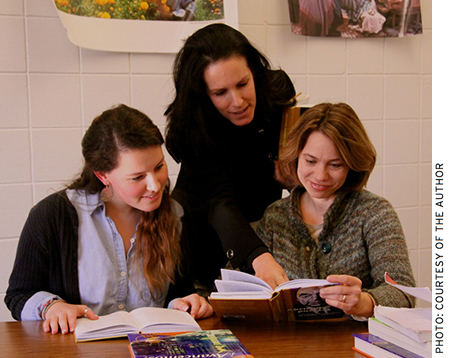“Your Spanish name will be Elena. You will play the piranha in this story and work with group two,” explained Señorita de Vizcarrondo. Elena took her place, preparing to become the piranha that almost eats Paco on his class trip down the Amazon River. But she was nervous about memorizing the lines. Elena wasn’t one of the 10th graders in intermediate Spanish. “Elena” was me, and I was then a 37-year-old teacher in the same high school, teaching English to the same kids among whom I sat that September day.
 When my school launched its Global Scholars Program seven years ago, I decided to begin auditing a Spanish class. I hoped to be an advisor to the new program, and burnishing my high-school Spanish would add to my credibility.
When my school launched its Global Scholars Program seven years ago, I decided to begin auditing a Spanish class. I hoped to be an advisor to the new program, and burnishing my high-school Spanish would add to my credibility.
Having recently completed my final year of study in the department with AP Spanish VI, I realize that improving my Spanish, while not insignificant, was the least of what I’ve done and learned. Long after the vocabulary and memorized passages have faded away, I’ll remember the experience of morphing each day into a student of my colleagues in the world language department and a classmate of my English literature students. It was the best and most important professional-development experience I’ve ever had.
My biggest hurdle—one our students face every day—was overcoming my fear of being humiliated. Many of my classmates had been studying Spanish since pre-kindergarten. I was the student who would need extra help to keep up. In fact, after my acting debut as the piranha, I had to drop down to Spanish III because I hadn’t attained the mastery of verb tenses expected of a Spanish IV student.
By the middle of the year, I looked forward to performing skits, even dressing up in various costumes. I had come to see that the students form a community, supporting each other in simple but significant ways. If I forgot my props, another student would readily loan me extra items. When groups walked forward to perform, seated classmates whispered “buena suerte,” or good luck, erupting afterward in spontaneous applause, regardless of whether what they’d seen was any good.
Our students must jump into the vulnerability box all the time, while we, as the designated experts, rarely do. They need our support to take the plunge. I gained an incredible amount of confidence the first year when my teacher, Señorita Morse, cultivated an environment in which it was OK to fail. I could mispronounce words, forget my lines, and speak at a snail’s pace, all with her and my classmates’ support.
My own lesson planning improved exponentially from sitting in my colleagues’ classrooms for entire courses. Had I swept in for a single day of Señorita Mielke’s unit on Gabriel García Márquez’s novella, Crónica de una muerte anunciada, I’d never have known how lessons on vocabulary, character analysis, and cultural context were all building toward the students’ mock trial of the Vicario brothers. Before long, I learned to adapt lessons for use in my English classes. Watching my sophomores lose their grip on the plot of The Strange Case of Dr. Jekyll and Mr. Hyde, I asked myself, “Well, what would the Spanish teachers do?” Answer: act it out. So we did.
Sitting in class with my students motivated me to work hard. At the same time, I was constantly reminded that English was not their only class, but just one of many that couldn’t always come first.
People now ask me if I’m fluent in Spanish. I don’t think it is really possible to become fluent in another language, unless perhaps you live in a foreign country and make the study of its language an integral part of your life.
So no: I am not fluent, even if I’ve come a long way from my bit part as a Spanish-speaking piranha. But while learning about Spanish-speaking cultures, I’ve also learned something of the one that surrounds me at work each day. I’ve become more empathetic toward my students and developed greater respect for my fellow teachers. In my six years of toggling between being a student and being a teacher, I’ve become much more adept at traversing the gap between my students’ world and mine. Our worlds aren’t so different: each of us who is now a teacher was once a student. Some of us still are.
Elaine Griffin is the English department chair at the University School of Milwaukee.
This article appeared in the Spring 2014 issue of Education Next. Suggested citation format:
Griffin, E. (2014). Try Being a Student: An English teacher’s journey into Spanish class. Education Next, 14(2), 88.


